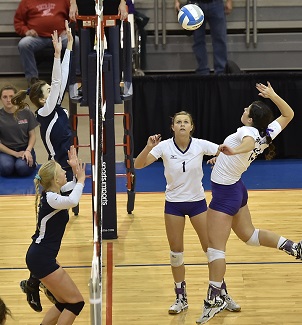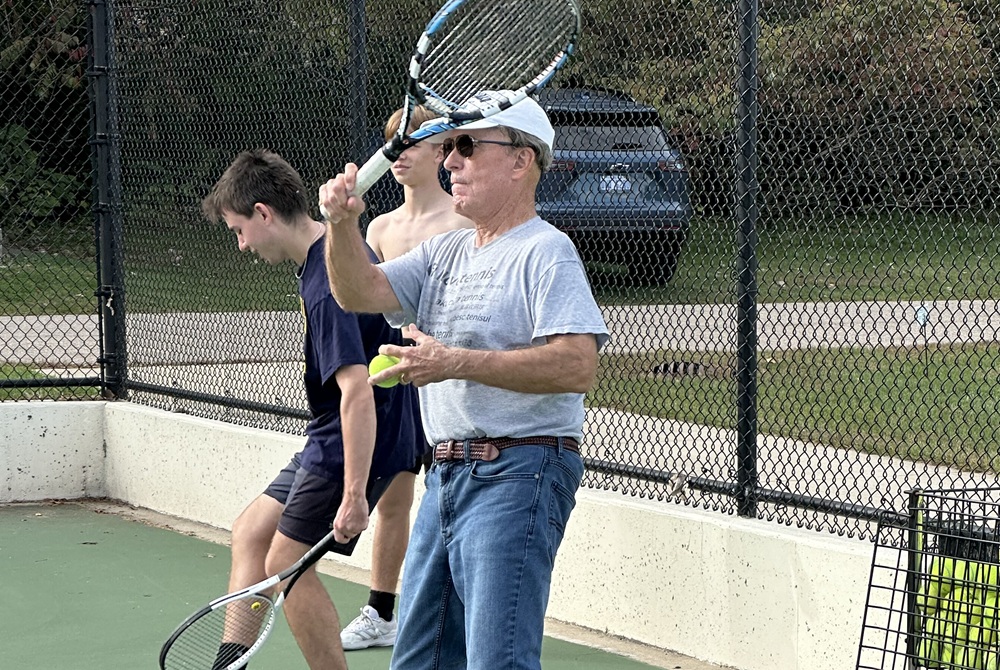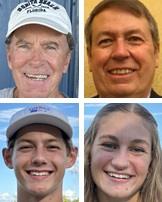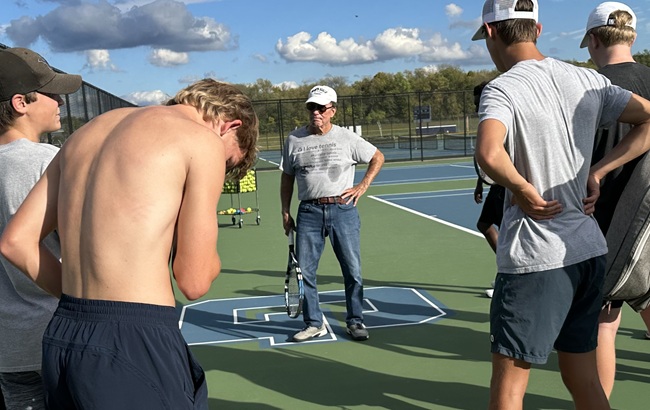
Task Force Building Multi-Sport Message
November 11, 2016
By Geoff Kimmerly
Second Half editor
Walled Lake Western’s Cody White draws his perspective on high school sports from a background that, while perhaps not unique, has to be close.
The Warriors senior is one of the top college football prospects in Michigan, a Big Ten-caliber player who has committed to continue his career at Michigan State University after he graduates in the spring.
Our state has a handful of athletes like that every year, of course. But White also is the son of former NFL player and Detroit Lions executive Sheldon White – and has followed his father’s Dayton, Ohio, footsteps in playing three sports during his high school career.
White plays football, basketball during the winter and baseball in the spring, in addition to travel basketball and baseball during the summer. He has played these same sports throughout high school. His freshman year he also competed in track & field, along with baseball. As of May – when White and his multi-sport experience were featured on Second Half – he hadn’t ruled out returning to track & field, in addition to baseball, as a senior.
“I couldn’t see myself not competing in those sports,” White said at the time. “I love them so much. I want to finish my senior year playing all three.”
It’s White’s experience, and the benefits enjoyed by so many who have shunned the recent trend toward specialization, that is driving the MHSAA’s Multi-Sport Task Force as it aims to promote the value of a varied sports experience through high school, even for athletes considered “elite” in a sport they’ll go on to play at higher levels.
The Multi-Sport Task Force met for the third time Oct. 27 and includes coaches, administrators and teachers with diverse experiences in athletics at schools large and small; urban, suburban and rural and in both the interscholastic and club settings.
The idea of moving away from specialization and back toward playing multiple sports has gained steam in recent years with pronouncements of how doing so paid off for nationally-recognized stars like professional golfer Jordan Spieth, baseball Hall of Famer John Smoltz and a number of members of the U.S. women’s soccer national team who played multiple sports through high school.
The MHSAA’s task force is working to develop that message, package it in the most digestible formats, and deliver it to the key decision-makers to benefit athletes at the age where the message can have the heaviest impact on their sports careers and growth into physically fit adults.
“This is a fundamental topic in school sports,” MHSAA Executive Director Jack Roberts told the task force during its most recent meeting. “This is something we’ll be talking about five and 10 years from now.”
The task force is charged with a series of goals that will be discussed below and are still in development. But there’s no doubt coaches will play a significant part in promoting and carrying out this important mission.
“Growing up was a little different (for me) than the usual kid. Going to Lions games and just being around football all the time. I think I love the game more because I was around it so much. But I think playing three sports helped me, too. The twisting of your hips in baseball, when you swing the bat, you’re using different muscles. And all the jumping you do in basketball. You have to move in tight spaces. With football, you’re with the football guys. By doing all three you meet different people.” – Cody White, “Western’s White Enjoys ‘Special’ Career” – May 4, 2016
What we’ve learned
The task force’s first meeting in April included discussions with Dr. Tony Moreno of Eastern Michigan University, a frequent Coaches Advancement Program instructor, and Dr. Brooke Lemmon of the MSU Sports Medicine Clinic. Among points from their focus on medical issues that result from specialization:
• Specialization has chronic, long-term affects; young people who do not learn physical literacy – how to solve movement problems – are less likely to be physically active and, hence, less likely to be physically fit. This is becoming an expensive health issue for society.
• The loss of physical education from schools is the root of these problems and has led to the creation of “privatized PE” for those who can afford a club sports experience. Physical education in schools, done correctly, can create a relatively noncompetitive environment that increases student interest in becoming physically active.
• More time spent in one activity will lead to more injuries, especially of the chronic nature. The number of hours per week a child spends on one sport activity shouldn’t exceed that child’s age (8 hours per week for an 8-year-old, for example).
Dr. Dan Gould, the director of the MSU Institute for the Study of Youth Sports, talked to the task force during its second meeting about how children perceive sports – and the need to adjust parents’ expectations for their kids’ success. He explained how kids can lose their identity focusing on just one sport, and also the importance of free play – the games kids make up themselves while playing in a structure-free environment.
Bob Mancini of USA Hockey visited with the task force most recently, explaining how his was the first governing body to tell athletes it wanted them to play their sport – but in order to do so well, play other sports also. USA Hockey’s American Development Model was launched in 2009 to in part promote multi-sport participation – and is growing hockey in the process, with increased participation seen at youth levels over the last three years.
“It’s just really fun to do different things. We don’t have a lot of the numbers, but we have the people who are willing to put in the hard work, even if it’s not their best sport. Each season is only three to four months at the most. So it keeps things exciting.”— 2016 Bronson graduate Kelsey Robinson, a defensive specialist in volleyball, former cross country runner, guard in basketball and a third baseman and centerfielder in softball, “Multi-Sport Experience ‘Special’ for Bronson” – February 2, 2016
Questions & Answers
The task force will meet again Feb. 8, and in the meantime there are a number of questions – and answers – to be considered.
The group has pinpointed a series of goals:
1. Partner with groups promoting diverse physical activity.
2. Encourage those promoting more and better physical education.
3. Prepare tools for administrators for use in interviewing prospective coaches, conducting meetings with their coaching staffs and encouraging them to “walk the talk” of balanced participation.
4. Assist in the explanation of the multi-sport experience to parents through a variety of media, including a guidebook and video explaining its benefits.
Carrying out these aspirations comes with plenty to discuss.
Who most needs to hear the message of multi-sport participation? It’s most likely junior high and middle school parents, or even those of elementary students just starting to experience organized athletics.
 What do these parents and children most need to know? Parents are stakeholders in their children’s athletic ventures. The challenge is convincing them our way is best for their kids’ futures, from a health and development standpoint.
What do these parents and children most need to know? Parents are stakeholders in their children’s athletic ventures. The challenge is convincing them our way is best for their kids’ futures, from a health and development standpoint.
Who should deliver this message? Celebrities obviously carry clout when they talk about how their multi-sport experiences led them to become successful adults. But there also could be a strong emotional tug from current student-athletes who tell their stories.
How can coaches and athletic directors help spread the word? The MHSAA, with input from the task force, will develop tools to help. But the options are many: could it come in video form, eye-catching graphics for use at coaches meetings, or live interaction at regional summits?
We are looking for ideas, both for getting out the message and incentivizing taking part in the multi-sport experience. Schools already are doing great things to promote multi-sport participation, and we’d love to hear about what's working.
To that vein, we’ll close with a final success story from this fall about a team that benefited from a lineup of multi-sport athletes:
Grosse Pointe Woods University Liggett on Oct. 15 ended an eight-year championship run by Ann Arbor Greenhills at Lower Peninsula Division 4 Boys Tennis Finals. Knights coach Matt Sobieralski relied on a roster filled with multi-sport athletes, including No. 1 singles player T.J. Dulac, who also ran cross country this fall.
Only one player on the Liggett roster plays only tennis, and Sobieralski says his players’ multi-sport participation served them well.
“It makes you tough, mentally tough and strong. And they’re competitive. That’s important. I think tennis, a lot of times, is 80 percent mental and 20 percent ability. You win a lot of matches with guts and just hanging in there. I always say a good player can win even when they’re not playing their best, because they’ll try something different and they keep fighting. That’s the team I’ve got. I’m really proud of their fight.” – Matt Sobieralski, “Liggett Ends Greenhills’ 8-Year Reign” – October 16, 2016
PHOTOS: (Top) Walled Lake Western's Cody White runs ahead of a group of Lowell defenders during last season's Division 2 Semifinals. (Middle) Bronson (right) goes for a kill during last season's Class C Semifinal against Traverse City St. Francis. (Top photo courtesy of Walled Lake Western athletic department.)

Built Right, No Rebuild Needed: Cornelius Taking Gull Lake Back to Tennis Finals
By
Pam Shebest
Special for MHSAA.com
October 21, 2025
RICHLAND – Once the boys season ends later this week, Roger Cornelius will begin preparing for his 50th year as varsity girls tennis coach at Gull Lake High School.
 That tenure may have been cut short at 22 years, if not for the Gull Lake tennis community.
That tenure may have been cut short at 22 years, if not for the Gull Lake tennis community.
In January 1998, Cornelius’ 16-year-old daughter, Lindsay, died as a result of a winter car crash.
He had recently ended the fall season with the girls team and “I didn’t know if I could (coach) the boys that spring,” he said, still emotional when talking about the tragedy.
One of his former students, Jason Ryan, now a vascular surgeon at Beacon Kalamazoo Hospital, contacted Cornelius.
“He and one or two other guys talked with me and, if not for them, I would have quit tennis,” Cornelius said. “I decided to continue with tennis, and I’m glad I did. I found out that God was going to carry me through the toughest time of my life. The tennis community was really big for me back then. Richland, especially, came beside me and lifted me up.”
Although tennis is his sport of choice, Cornelius played football at Western Michigan University and was first hired at Gull Lake in 1975 to help with the football program. He jumped at the chance to coach the tennis team that spring and has coached either the boys or girls, and sometimes both, every year since.
He has been named Regional Coach of the Year several times and was enshrined in the Michigan High School Tennis Coaches Association (MHSTeCA) Hall of Fame in 2018.
Cornelius will lead the boys (12-2-1) to the MHSAA Lower Peninsula Division 3 Finals this Friday and Saturday at Midland Tennis Center. The Blue Devils finished 10th the last two years, earning eight points both times.
In a rebuilding year after losing all four singles and two doubles players to graduation, Cornelius was surprised and thrilled that this year’s team earned 20 points at its Regional, finishing second to St. Joseph and qualifying for the Finals.
At the beginning of the season, senior Peyton Orley said he wasn’t sure how good the team would be.
“Last year at the beginning of the season, we could tell we had a really good team,” Orley said. "This year, we lost a lot of our seniors and it didn’t look promising for states.
“Everyone on the team was mission-motivated to get to the state tournament.”
 Orley pairs with senior Sullivan Abegg at No 1 singles and the pair did their part, winning their Regional flight. For Abegg, it was a three-peat after taking the title at No. 3 doubles two years ago and No. 2 doubles last year.
Orley pairs with senior Sullivan Abegg at No 1 singles and the pair did their part, winning their Regional flight. For Abegg, it was a three-peat after taking the title at No. 3 doubles two years ago and No. 2 doubles last year.
The Blue Devils are led at No. 1 singles by freshman Kade DeMaagd, whose father also played for Cornelius.
“Kade’s got the best strokes on the team,” the coach said.
Lucas Nichols, at No. 4 doubles, is the other freshman in the lineup. The other three seniors are Max Uppal (No 3 singles) and Dylan Piwko and Evan McCann, both doubles players. Three juniors, who all play doubles, are Jaden Jones, Jackson McDermott and McGuire Abegg. Two sophomores round out the singles flights: Jake Worgess at No. 2 and Jacob Nichols at No. 4.
Comparing old & new
Cornelius said there isn’t much difference between the tennis players today compared to those 50 years ago.
“I think what’s changed the most is today’s athletes have so many different options, so many different interest areas,” he said. “A lot of the kids have early college classes, some of them have to come to practice from off site and so many things are happening, whether it’s the Model United Nations or tutoring someone at the high school or DECA. I think that’s the biggest difference.”
While the boys are competing in Division 3, the girls are in Division 2, a more difficult road to the Finals, Cornelius said.
“It does make it pretty tough for the girls to make it out of Division 2 with the Mattawans, Portage Central, St. Joe, Battle Creek Lakeview,” he said.
Orley’s sister, Ava, a junior who plays at No. 1 doubles, said the girls team has already bonded.
“We build our team off loving each other,” she said. “It’s not everyone out for themselves, it’s all of us (working together). We focus on being a good role model.
"We’ve had coaches tell us how we played with class and how it’s an honor to play us because we learned from (Cornelius) that you always want to be a good sport.”
Competitive, compassionate
Cornelius, who taught French at the high school for 32 years, currently tutors French-speaking African and Haitian families for the district.
“I tutor the kids and work with the families,” he said. “It’s vastly different than what I did in the classroom. The greatest thing that’s ever happened to me in my nearly 50 years working with Gull Lake schools was working with a little African boy who was blind.”
Cornelius and some friends pooled money to take the boy to a specialist in Grand Rapids. The specialist asked Cornelius to translate for the mother that he thought he could help the young boy regain some sight.
“The two surgeries were successful,” said Cornelius, choking up a bit with emotion. "He has to wear glasses, but he can see. It’s the high watermark of my life.”
That compassion is visible on the tennis courts, said retired Allegan coach Gary Ellis, now a volunteer assistant tennis coach at the school.
 “I’ve known Roger since 1977,” Ellis said. “We started competing against each other when he started coaching the boys.”
“I’ve known Roger since 1977,” Ellis said. “We started competing against each other when he started coaching the boys.”
He said that although Cornelius wants to win and likes to compete, “at the same time, he’s got a good perspective on the whole thing and the value of high school sports, and tennis in particular. He’s very positive, both with his team and with the opponents.”
Cornelius was so supportive of opponents that one year Ellis’ girls team invited the Gull Lake coach to their awards banquet at the end of the season.
“He had a conflict and couldn’t attend, but he sent a really nice letter to the girls,” Ellis said.
Cornelius makes it a point to talk with opponents, both coaches and players.
“I love to get to talk to the kids that I would never get to talk with,” he said. “My favorite is Battle Creek Central because they have struggles that most of us at Gull Lake don’t know about.
“For them to commit their spring or their fall to tennis, that’s a major decision. I want to make darn sure that after the match, I get to meet every one of them, talk with them, talk with their coach.”
Cornelius doesn’t expect this to be his last season.
“I will step down when the good Lord says, ‘I think it’s time,’” he said. “And I don’t think it’s time quite yet.
“I wouldn’t mind if they put on my gravestone ‘Loved God, Loved People.’”
 Pam Shebest served as a sportswriter at the Kalamazoo Gazette from 1985-2009 after 11 years part-time with the Gazette while teaching French and English at White Pigeon High School. She can be reached at [email protected] with story ideas for Calhoun, Kalamazoo and Van Buren counties.
Pam Shebest served as a sportswriter at the Kalamazoo Gazette from 1985-2009 after 11 years part-time with the Gazette while teaching French and English at White Pigeon High School. She can be reached at [email protected] with story ideas for Calhoun, Kalamazoo and Van Buren counties.
PHOTOS (Top) Richland Gull Lake tennis coach Roger Cornelius hits with his players during practice this season. (Middle) Clockwise from top left: Cornelius, assistant Gary Ellis, junior Ava Orley and senior Peyton Orley. (Below) Cornelius talks things over with his team. (Photos by Pam Shebest.)

